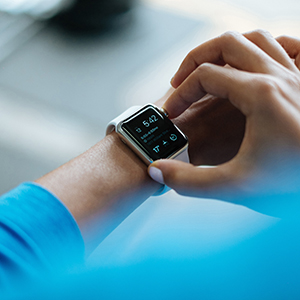Wearing Wellness on Your Sleeve: How Wearable Tech Is Changing Healthcare Services

The focus on wearable technology is set to amplify both consumer eHealth and the health insurance industry. Wearable technologies are a category of tech devices that track information related to the health and fitness of users. For example, wearable tech can track and analyze physical activity and eating patterns, in order to help manage health concerns like hypertension, diabetes and obesity.
Wearables are considered a form of “living services,” because the devices engage users in real-time, adjusting to users’ varied needs and expectations. This represents a natural evolution of the Internet of Things, and begs the question: with one in five Americans owning a wearable tech device, will this kind of living service change how health care services are regulated?
Fitness bands and smartwatches are some of the most popular wearable devices on the market, with 61 percent and 45 percent of Americans wearing them, respectively. Additionally, 46 percent of consumers believe wearable technology will help them lose weight and 56 percent of consumers believe wearable technology that monitors vital signs can increase the average life expectancy by 10 years.
The integration of wearables with insurance is still in its infancy, but companies have been testing programs to demonstrate various benefits. Humana uses wearables to reward fitness-related activity by offering users reduced premiums, gift cards and nifty health devices. While the program, HumanaVitality, is in its early stages, a three year study of Humana employees showed HumanaVitality participants saved 18 percent on health care and enjoyed a 44 percent decrease in sick days.
Progressive uses wearable technology in cars to track and reward safe driving practices. Of the people who have participated in this program, called Progressive Snapshot, 54 percent say they’ve made changes to the way they drive since installing the device.
It’s estimated that over the course of the next five years, wearables and remote patient monitoring technologies could cut hospital costs by as much as 16 percent. A survey conducted in 2014 found that, of all health insurers, three percent currently use wearable devices, three percent are experimenting with the technology and 22 percent are working on a wearables strategy.
A more recent survey, conducted by Insurance Journal, found 63 percent of insurance industry executives believe wearables will be widely adopted by the industry within the next two years. The survey also found consumers were more likely to use health-tracking wearables if it saved them money on health insurance premiums and allowed their physicians to offer better health care.
Wearable technology gives insurance providers the ability to increase customer engagement and track activity, but it won’t stop there. Wearable programs are constantly being fine-tuned, in order to further benefit insurance providers and subscribers. “Our students’ broader focus is asking how living services will change health care services delivery and future regulation of HIT. Commercial insurance services coverage is one facet of this broader question because as public health insurers go, generally, so go commercial insurers,” says Susan Hahn-Reizner, who is on the advisory board of Northwestern’s MS in Health Informatics.
Long-term wearable tech benefits include real-time payment adjustments, which would eliminate the need for annual payment adjustments. In addition to rewarding healthy behavior recorded by wearables, insurance companies are exploring the possibilities of punishing or discouraging unhealthy activity tracked by wearable tech. Despite a slow rise of wearables being used within insurance policies, the market for wearables is expected to grow 150 million units by 2019.
